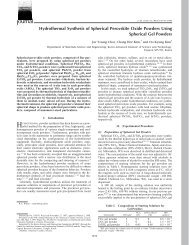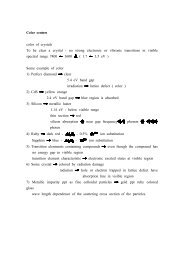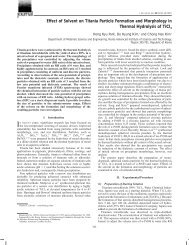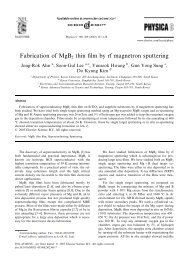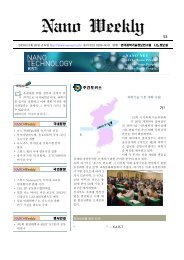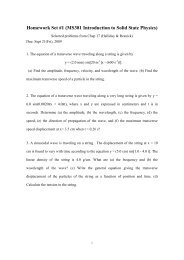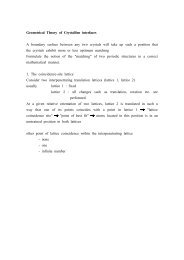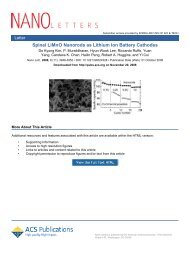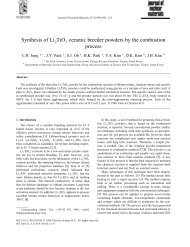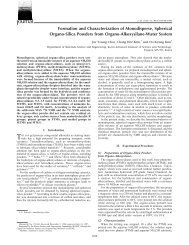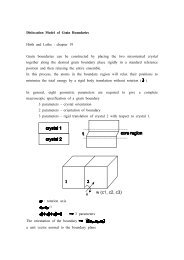Hydrogen storage characteristics of metal oxide doped Al–MCM-41 ...
Hydrogen storage characteristics of metal oxide doped Al–MCM-41 ...
Hydrogen storage characteristics of metal oxide doped Al–MCM-41 ...
Create successful ePaper yourself
Turn your PDF publications into a flip-book with our unique Google optimized e-Paper software.
activated carbons, a material, which has appreciable<br />
hydrogen uptake values at cryogenic temperatures [9]. Previous<br />
studies have reported that zeolites can store small<br />
amount <strong>of</strong> hydrogen (0.3 wt%) if loaded at room temperature<br />
[10–12] or at temperatures >200 °C [11,12]. But, at<br />
cryogenic temperatures, substantially higher hydrogen<br />
<strong>storage</strong> capacities (>1 wt%) can be achieved. Adsorption<br />
in zeolite is a matter <strong>of</strong> pore filling and the usual surface<br />
area concepts are not applicable. The forces involved in<br />
this process are essentially physical (dispersive) and the<br />
enthalpies involved are low [13]. The primary focus has<br />
predominantly been on zeolites among the aluminosilicates,<br />
to date.<br />
The objectives <strong>of</strong> this contribution are to present our<br />
preliminary promising catalytic results <strong>of</strong> the hydrogen<br />
adsorption capacity <strong>of</strong> mesoporous MCM-<strong>41</strong> [14]. However,<br />
like zeolites these materials are not sufficiently light<br />
to represent the final solution <strong>of</strong> H2 <strong>storage</strong>. However, they<br />
can also be ideal systems to investigate the interaction <strong>of</strong><br />
H2 with both dispersive and electrostatic forces [12]. The<br />
basic idea is to find an appropriate <strong>metal</strong> cation to modify<br />
MCM-<strong>41</strong> and to find the relation between the cation and<br />
hydrogen <strong>storage</strong> property. Since, their transition <strong>metal</strong><br />
substituted derivatives have been in focus <strong>of</strong> research as<br />
well and have created a renaissance <strong>of</strong> interest in the synthesis<br />
<strong>of</strong> porous materials [15]. Hitherto, the real effect <strong>of</strong><br />
mono<strong>metal</strong>lic nickel on the level <strong>of</strong> hydrogen <strong>storage</strong> has<br />
not still received much attention [16]. Zielinski et al.<br />
reported the hydrogen <strong>storage</strong> capacity <strong>of</strong> nickel catalysts<br />
supported on amorphous activated carbon [17]. Mesoporous<br />
materials can accommodate nanoparticles <strong>of</strong> very high<br />
adsorption properties. This is the driving force in us to<br />
select mesoporous materials for hydrogen adsorption.<br />
The work presents the performance <strong>of</strong> various <strong>metal</strong> <strong>oxide</strong>s<br />
such as TiO2, Cr2O3, Fe2O3 and NiO <strong>doped</strong> <strong>Al–MCM</strong>-<strong>41</strong><br />
materials in the hydrogen <strong>storage</strong> capacity.<br />
2. Experimental<br />
The <strong>Al–MCM</strong>-<strong>41</strong> (Si/Al = 25, 50, 100 and 200) was<br />
synthesized hydrothermally in a Teflon-lined stainless steel<br />
autoclave at 100 °C for 48 h, according to the procedure<br />
described earlier [18]. The typical gel composition was<br />
2SiO2:0.27(CTA)2O:0.26Na2O:0.26(TMA)2O:0.017Al2O3:<br />
120H2O. The acid form <strong>of</strong> <strong>Al–MCM</strong>-<strong>41</strong> was prepared from<br />
the Na form <strong>of</strong> <strong>Al–MCM</strong>-<strong>41</strong> as per the procedure described<br />
earlier [18]. The Ni–<strong>Al–MCM</strong>-<strong>41</strong> (25) was synthesized by<br />
adopting the same procedure using nickel nitrate as the<br />
source for nickel. The <strong>Al–MCM</strong>-<strong>41</strong> was used as the host<br />
material to include various guest <strong>metal</strong> <strong>oxide</strong>s. The <strong>metal</strong><br />
<strong>oxide</strong>s were impregnated by Incipient Wetness Impregnation<br />
(IWI) method using <strong>metal</strong> nitrate. The resulting (as-synthesized)<br />
<strong>Al–MCM</strong>-<strong>41</strong>, Ni–<strong>Al–MCM</strong>-<strong>41</strong> and the impregnated<br />
materials were calcined at 550 °C in nitrogen for 1 h followed<br />
by air for 5 h. The materials were characterized by various<br />
physicochemical techniques. The crystallnity <strong>of</strong> samples<br />
were interrogated by powder X-ray diffractometer (D/max-<br />
S. Ramachandran et al. / Catalysis Communications 8 (2007) 1934–1938 1935<br />
IIIC, Rigaku, Tokyo, Japan). The textural properties were<br />
measured by N2 sorption method. Structural characterization<br />
was analyzed by Transmission electron microscope<br />
(F-20 Tecnai, Philips).<br />
The acidity <strong>of</strong> the <strong>Al–MCM</strong>-<strong>41</strong> (25, 50, 100 and 200)<br />
samples was analysed by TPD–NH3 using TGA method.<br />
Adsorption <strong>of</strong> ammonia was carried out on each sample<br />
in a quartz tube packed with 1.0 g <strong>of</strong> the catalyst. Initial<br />
flushing was carried out with dry nitrogen for 3 h. Then<br />
the system was evacuated (1.5 · 10 –5 Torr) at 550 °C for<br />
5 h and cooled to room temperature. Ammonia adsorption<br />
was carried out by passing the ammonia vapours over the<br />
catalyst bed. After adsorption, the system was evacuated to<br />
remove the physisorbed ammonia and again ammonia was<br />
passed through the system. The adsorption and evacuation<br />
processes were repeated five times for saturation <strong>of</strong> adsorption.<br />
The extent <strong>of</strong> ammonia adsorbed over each catalyst<br />
was measured by TGA in a TA 3000 Mettler system. Nitrogen<br />
as purge gas was passed during desorption <strong>of</strong> ammonia.<br />
The TGA study was conducted at a heating rate <strong>of</strong><br />
10 °C/min up to 600 °C.<br />
<strong>Hydrogen</strong> adsorption measurements were carried out<br />
over <strong>Al–MCM</strong>-<strong>41</strong> and the <strong>metal</strong> <strong>oxide</strong>s <strong>doped</strong> <strong>Al–MCM</strong>-<br />
<strong>41</strong> materials. The adsorbents are mostly hydrophilic so,<br />
prior to adsorption measurements, water is completely<br />
removed by activation at 550 °C for 6 h. About 0.05 g <strong>of</strong><br />
the catalyst was loaded in a stainless steel bomb and<br />
mounted in a closed refrigerator. After evacuating the vessel,<br />
the sample was brought in contact with a definite<br />
amount <strong>of</strong> hydrogen under a well regulated pressure for<br />
a calculated time period. Degassing was achieved at room<br />
temperature by purging argon. A high pressure in the order<br />
<strong>of</strong> 15 MPa forces the hydrogen to enter the cavities, and<br />
then a decrease in the temperature traps the hydrogen<br />
inside the framework. This mechanism <strong>of</strong> the TO4 tetrahedral<br />
material enables hydrogen <strong>storage</strong>. Similarly, a temperature<br />
increase allows hydrogen release. The amount <strong>of</strong><br />
hydrogen desorbed was measured using gas chromatography.<br />
<strong>Hydrogen</strong> adsorption values were expressed in terms<br />
<strong>of</strong> weight percent (wt%) hydrogen in materials.<br />
3. Results and discussion<br />
3.1. Characterization<br />
The XRD patterns <strong>of</strong> the calcined <strong>Al–MCM</strong>-<strong>41</strong> materials<br />
with Si/Al ratio 25, 50, 100 and 200 are presented in<br />
Fig. 1. The catalysts exhibit an intense peaks in the 2h <strong>of</strong><br />
1.8–2.2° due to (100) reflection, and small peaks due to<br />
higher order (200) and (210) reflections indicating the formation<br />
<strong>of</strong> well ordered mesoporous materials [19]. The unit<br />
cell dimensions estimated from XRD data show an increase<br />
in cell volume with increasing aluminum content. The isotherms<br />
<strong>of</strong> nitrogen adsorption and desorption on the mesoporous<br />
<strong>Al–MCM</strong>-<strong>41</strong> (25) is shown in Fig. 2. It presents a<br />
type IV isotherm according to the classification <strong>of</strong> Brunauer<br />
et al. [20]. The isotherm displays a typical step at



